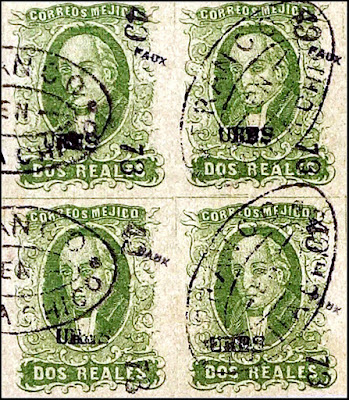Ten different types of forgery of the CR issues have been identified by Rodger and Duberal. The most commonly found forgeries are those made by Spiro.
He copied the design of the one penny CR issue and re-used most of it for his versions of the three pence and six pence values.
This mistake (or laziness) on his part makes it very easy to recognise his forgeries of the latter two values. Some, but not all, of
the other forgers made the same error.
Imperforate stamps were specially sold to stamp dealers (never used for postage).
Genuine Issue
Characteristics of the genuine stamp
Paper: wove, thin and rather brittle, perforated 12.5, line.
Some stamps may show part of the watermark FIJI POSTAGE which appears in a straight line across the middle of the sheet.
Note: these stamps may also be found on laid paper, probably from the printers' waste which was sold through the Crown Agents in 1889.
Design: There are 60 white "pearls" of uniform size around the central circle.
The base of the crown is flat.
The central bar of the letter "E" is about half the length of the upper and lower bars.
Forgeries
Characteristics of the Spiro forgery
Paper: wove, but softer and thicker than the genuine, no watermark.
They have irregular pin-perfs gauging approximately 11.5 but they may be found gauging from 11 to 13.5 (compound) and also imperforate.
Design: there are 55 "pearls", uneven and sometimes oval in shape, around the central circle.
The base of the crown is rounded.
Faint perforation guide lines may be visible.
Characteristics of the forgery by Mercier
Paper: Wove, thin and brittle, similar to the genuine, but toned.
They may be found with perforations gauging from 11 to 13.25 (compound).
Design: The central circle has 56 irregular pearls.
The "S" in "SIX" is regular in shape.
The triangles between the central circle and the value label are solid white lines instead of dotted.
The base of the crown is rounded.
They are probably made by the forger Oneglia. They appeared in his 1906 price list
Torres Forgery
The J is cut off on the bottom
The pearls are white instead of green
The corner elements do not match the original
The middle bar of the E's are too long
It has his cancel type
Unknown forger
Characteristics of the forgery
Paper: Wove, thicker than the genuine. Perforated 10.5
Design: The central circle has zig-zag lines, but these are darker and more pronounced than in the genuine stamp.
The middle bar of the "E" in "POSTAGE" is too long.
The base of the crown is rounded.
Unknown forger
Characteristics of the forgery
Paper: wove, similar in thickness to the genuine stamp, perforated 11.5.
Design: The base of the crown is slightly rounded and the central circle consists of white pearls.
The horizontal bars of the letter "E" are all the same length.
The letters are crude and uneven
Overall a poor attempt
Forger unknown
The words "FIJI" and "POSTAGE SIX PENCE" are in red on a white background (like the genuine 1 p and 3 p).
However, the genuine stamps have these words in white on a red background.


















































